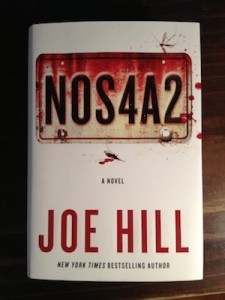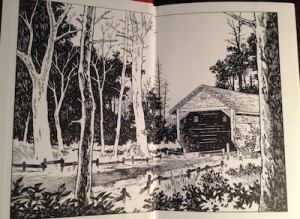Joe Hill has a new book out, and it’s filled with references to his father, Stephen King, to David Mitchell, and to Gerard Manley Hopkins (and to others, I’m sure). Although the references to Mitchell are somehow the most surprising to me, it’s the references to Hopkins’s notion of “inscape” that intrigue me the most. (Then again, it’s the use of “inscape” that might explain the references to Mitchell.)
“Inscape”
 There are a few characters in the novel who have special creative abilities. The protagonist, Vic McQueen, can find lost objects or people using her “Shorter Way Bridge,” when she travels over it with a vehicle of some sort (a bike, a motorcycle, etc.). Charlie Manx, the principle villain, uses his own vehicle, a Rolls Royce Wraith, to take children to a place called “Christmasland,” a place in his “thoughtworld” or “world of inscapes” that’s inaccessible to anyone without a special creative inscape or ability.
There are a few characters in the novel who have special creative abilities. The protagonist, Vic McQueen, can find lost objects or people using her “Shorter Way Bridge,” when she travels over it with a vehicle of some sort (a bike, a motorcycle, etc.). Charlie Manx, the principle villain, uses his own vehicle, a Rolls Royce Wraith, to take children to a place called “Christmasland,” a place in his “thoughtworld” or “world of inscapes” that’s inaccessible to anyone without a special creative inscape or ability.
Another of these characters with special abilities, Maggie Leigh, works in a library and through her extensive reading she discovers that Hopkins’s notion of “inscape” describes these special creative abilities perfectly. According to Catherine Phillips’s introduction to the Oxford edition of Hopkins’s major works, “Inscape is often used of the characteristic shape of a thing or species. An artist’s analysis, […] it is used for the crucial features that form or communicate the inner character, essence, or ‘personality’ of something; one portrait is preferable to another, for example, because it conveys not just a passing mood but the personality of which that mood is a part.” Inscape is “the result of mental analysis and perception” (xx).
What’s interesting here is the importance of the observer, the necessary interplay between the thing and the artistic observation of the thing, in creating that inscape or essence. The inscape is the truth, yet it is the “result of mental analysis and perception.” Even if that perception or artistic representation is fictional, it’s what captures the real essence. The same is true in NOS4A2, as Maggie explains:
There’s the real world, with all its annoying facts and rules. In the real world, there are things that are true and things that aren’t. Mostly the real world s-s-s-suh-sucks. But everyone also lives in the world inside their own head. An inscape, a world of thought. In a world made of thought—in an inscape—every idea is a fact. Emotions are as real as gravity. Dreams are as powerful as history. Creative people, like writers, and Henry Rollins, spend a lot of their time hanging out in their thoughtworld. S-s-strong creatives, though, can use a knife to cut the stitches between the two worlds, can bring them together. Your bike. My tiles. Those are our knives. (p. 100) [fn. 1]
The point above is the use of creativity by these “strong creatives” to learn about the world around them, to cut into it and get at its essence. And as with Gerard Manley Hopkins, the inscape world, or the thoughtworld, or the idea-world, is real. (“Emotions are real as gravity. Dreams are as powerful as history.”) Later in the novel, Maggie says of Christmasland, “Oh, it’s a real place. Ideas are as real as rocks. Your bridge is real, too, you know” (p. 552). I’m reminded here of Žižek’s virtuality of the Real:
The big Other is a virtual order which exists only through subjects ‘believing’ in it; if, however, a subject were to suspend its belief in the big Other, the subject itself, its ‘reality,’ would disappear. The paradox is that symbolic fiction is constitutive of reality: if we take away the fiction, we lose reality itself. (Less Than Nothing 93).
For Žižek, as for Joe Hill and Gerard Manley Hopkins, ideas constitute reality. Now, this goes far beyond saying, “Well, sometimes really good ideas affect reality.” I mean, that’s just patently obvious, and fairly banal. Who doesn’t understand that? Žižek goes further, saying that ideas constitute reality. The Real is itself virtual. The capital-R Real, the real Real, the Real that is so Real we can’t actually full access it, is virtual (though the Real is still that which “resists” symbolization). In NOS4A2, this means that creativity is important; and fiction is important. The truth is accessed — insofar as it can be accessed — through fiction. In an interview, Hill calls NOS4A2 his “senior thesis on horror fiction.” [fn. 2] Throughout the novel, Hill highlights the importance of fiction itself, and he engages with what [horror] fiction is, or what it’s potential is.
Vic McQueen, uses her special inscape ability to find things she’s lost, such as a photograph she left at school, or a fancy bracelet left in a restaurant. And what she needs to do this is a “vehicle” and a “bridge.” Sound familiar? It sounds to me like the very definition of a metaphor. When Vic explains her creative ability, she says, “People who could do impossible things if they had the right vehicle” (p. 311; my emphasis; see also p. 408 for the same basic phrasing). Vic’s “vehicle” is a bike that she has to drive headlong over a shaky wooden “bridge” called the “Shorter Way Bridge.” By definition, metaphors are conceptual bridges. They unite two unlike things; they take “the shorter way.” In order to do this they use a “vehicle.” In rhetoric, the “vehicle” of a metaphor is the unlike object to which the comparison is made. For example, if I compared my mistress’ eyes to the sun, the eyes are the “tenor” and the sun is the “vehicle.” [fn. 3] The vehicle is what takes your understanding of a given idea to a new conceptual realm.
Vic’s journeys over her bridge are headlong (sometimes her brakes aren’t even fully working), and she never knows if it’s safe to cross, or where she’s going to end up. Isn’t this the experience of the creative act? You don’t know what you’re going to write before you write it. It’s dangerous. You try something, rushing headlong into it, and you don’t know if it’s going to work, where you’re going to end up, or what you’re going to find.
In her spare time Vic writes a successful children’s book about a character called “Search Engine.” Why “Search Engine”? Because that’s what her Shorter Way Bridge is for: searching for lost objects. And, as above, isn’t this a good way of thinking about what the creative act is like? It’s a search until you realize, Yes, this is what I was looking for, and this word choice or metaphor is just right—I’ve found it, and this finally captures that essence I was looking for, but could not yet articulate. Thomas Carlyle said the Poet says what all men were longing to say. Percy Shelley said the Poet sees the future in the present, and that poets are the unacknowledged legislators of the world. In a weird way, I think Joe Hill is playing in the general area of this tradition; he’s engaging with how the writer or the poet makes that headlong leap using the semantic or metaphoric bridge to find what was already there, just out of our reach, lost then found. Which metaphor, which clearly “unrealistic” intrusion of the supernatural captures the “real” essence?
The Ethics of Horror Fiction in NOS4A2
It’s with Charlie Manx, the villain of the novel, where it becomes clear what Hill is doing with inscape’s relation to horror. Like Vic, Manx uses a creative, metaphoric “vehicle.” Only this time his vehicle is evil—a Rolls Royce “Wraith” with license plate number “NOS4A2.” Manx uses his inscape and his vehicle to drain “unhappiness” from the children he kidnaps, when he brings them to Christmasland, a place where it is Christmas every day. This destroys the children, because when they “can’t understand anything except fun” they’re literally turned into monsters. Maggie says, “Innocence ain’t all it’s cracked up to be, you know. Innocent little kids rip the wings off flies, because they don’t know any better. That’s innocence” (p. 552). Wayne, Vic’s own child, begins doing this to a butterfly when he is kidnapped by Manx. In short, children can be little sociopaths if they don’t understand or care what’s evil, or horrific.[fn. 4] According to NOS4A2, you need both innocence and experience, happiness and unhappiness, in order to be a balanced human being. You need a little bit of horror fiction, says Hill. It’s good for you. Because if you rob someone of their ability to experience horror, such that the horror isn’t horror, then where does that leave you? You’ll be like Wayne, ripping wings off butterflies and not understanding what’s wrong with that.
Although he is a “strong creative,” Manx’s monstrosity stems from his lack of imagination. Christmasland represents the “limits of Charlie Manx’s imagination” (p. 641). He can’t imagine or understand the horror of a situation. Maggie describes Christmasland as Manx’s “idea of endless fun, endless youth, dressed up in a form his dumb little mind can understand” (p. 552). It is this idiocy, this limited imagination that turns Manx into a monster, and allows him to turn the children he kidnaps into monsters in precisely the same kind of way. During the climactic battle, Vic realizes, “Whatever the children had become, whatever [Manx] had done to them, he had done to make them safe, to keep them from being run down by the world. He believed in his own decency with all his heart. So it was with every true monster, Vic supposed” (p. 651).
George Eliot agreed with Adam Smith’s The Theory of Moral Sentiments that “the sympathetic imagination is the foundation of all morality” (Austen 560). And for Eliot, literature fostered this imagination. I suspect that although George Eliot was a staunch Victorian realist, she and Joe Hill are really on the same page. (See also Dickens’s contrast between Fact and Fancy in Hard Times for more of the same idea from another Victorian “realist.”) A weak imagination means an inability to sympathize with others—one fails to imagine oneself in another’s shoes. If that someone else is experiencing something horrific, you won’t sympathize in the proper way. And if you can’t sympathize, you don’t fully understand what’s happening.
Hill explores the effects of a lack of imaginative sympathy further after Manx is defeated. We realize that Manx’s kidnapping victim, Wayne, is still damaged by his experience. Wayne discovers that he takes a kind of sick pleasure in horrific things. When he sees things like a plane crash or news stories about wars in other parts of the world, Wayne feels “charged, jolted by excitement and guilt, as if he were looking at pornography” (p. 677). This is the flipside of horror fiction; it’s exactly what happens when horror loses half its effect, and becomes, instead, a kind of pornography. In the interview I quote from above, Hill notes “I’ve always detested when horror in the late ’90s turned into torture-porn,” because such works “failed at accomplishing the aims of horror.” In other words, they left out the most important part, the ethical dimension of horror. This is also the hardest part, because it requires real imagination. You have to imagine yourself in the shoes of the victim in order for the horror to really hit home, in order for you to fully understand it.
The references to David Mitchell, especially those to Jacob de Zoet, make a little bit more sense in this context. Even though it’s set at the turn of the nineteenth century, The Thousand Autumns of Jacob de Zoet is very much about finding a moral compass in the modern world; so too is NOS4A2. The generational conflicts, and especially the long echoing effects of individual actions — which I’ve talked less about here — also helps explain the references to Mitchell’s Cloud Atlas. The thinking about the nature of creativity, and the ways in which the artistic process is an encounter with the New, a headlong rush over a shaky bridge into the unknown, seems one of the most important ways in which NOS4A2 engages with the work of Hill’s father, Stephen King; I’m reminded of the latter books in the Dark Tower series, in which King often talks about how he doesn’t know what’s going to come next, and can’t control the story as much as he’d like. (The author is just a channel for Gan or whatever.)
I find it refreshing to see horror that wrestles with the problems of its own genre, and with fiction more generally. I agree with Wayne Booth that there is a “rhetoric of fiction.” Every novel takes a stance, posits an implied author, puts you into a subject position, regarding this or that theme or ethical dilemma. This is not true only of propaganda fiction–all fiction does this, and must do this. The really good novels question or complicate their own stance, or the stance of their entire genre, as well as the nature of how such stances come to be. To my mind, NOS4A2 succeeds in this endeavor.
Footnotes
[1] The reference to the knife reminds me of Carol Ann Duffy’s “Little Red Cap,” in which the speaker discovers that the poet-wolf she’s sleeping with “howls the same old song at the moon, year in, year out, / season after season, same rhyme, same reason,” so she ventures out on her own, and uses an axe (read: a pen) to deconstruct the world around her: “I took an axe / to a willow to see how it wept. I took an axe to a salmon / to see how it leapt. I took an axe…” (lines 35-8).
[2] Joe Hill interview at the AV Club.
[3] You probably shouldn’t compare your mistress’s eyes to the sun, though. Shakespeare basically already called you out on how lame this is.
[4] The Onion agrees: Kids are sociopaths.
Other References
Austen, Zelda. “Why Feminist Critics Are Angry with George Eliot.” College English 37.6 (1976): 549-61. Print.
Hill, Joe. NOS4A2: A Novel. New York: William Morrow, 2013. Print.
Phillips, Catherine. “Introduction.” Gerard Manley Hopkins: The Major Works. Oxford: Oxford UP, 2009. xv-xxxv. Print.
Žižek, Slavoj. Less Than Nothing: Hegel and the Shadow of Dialectical Materialism. London: Verso, 2012. Print.

